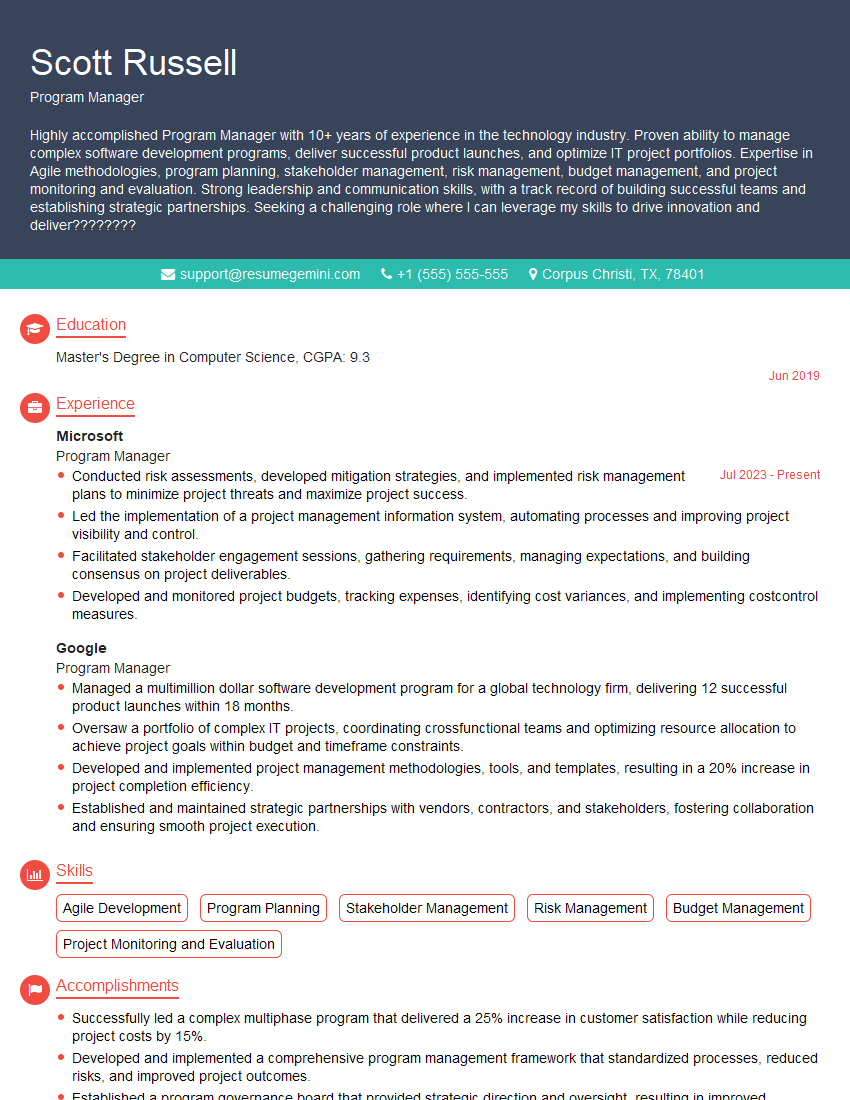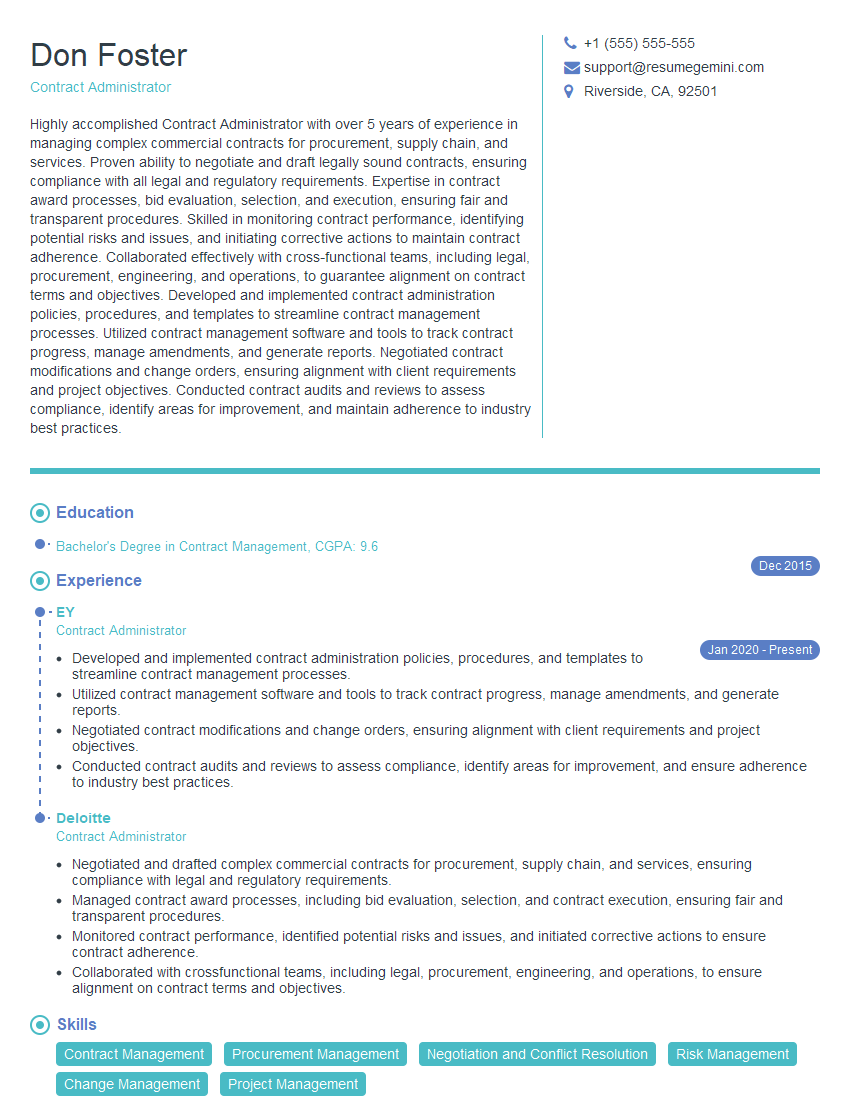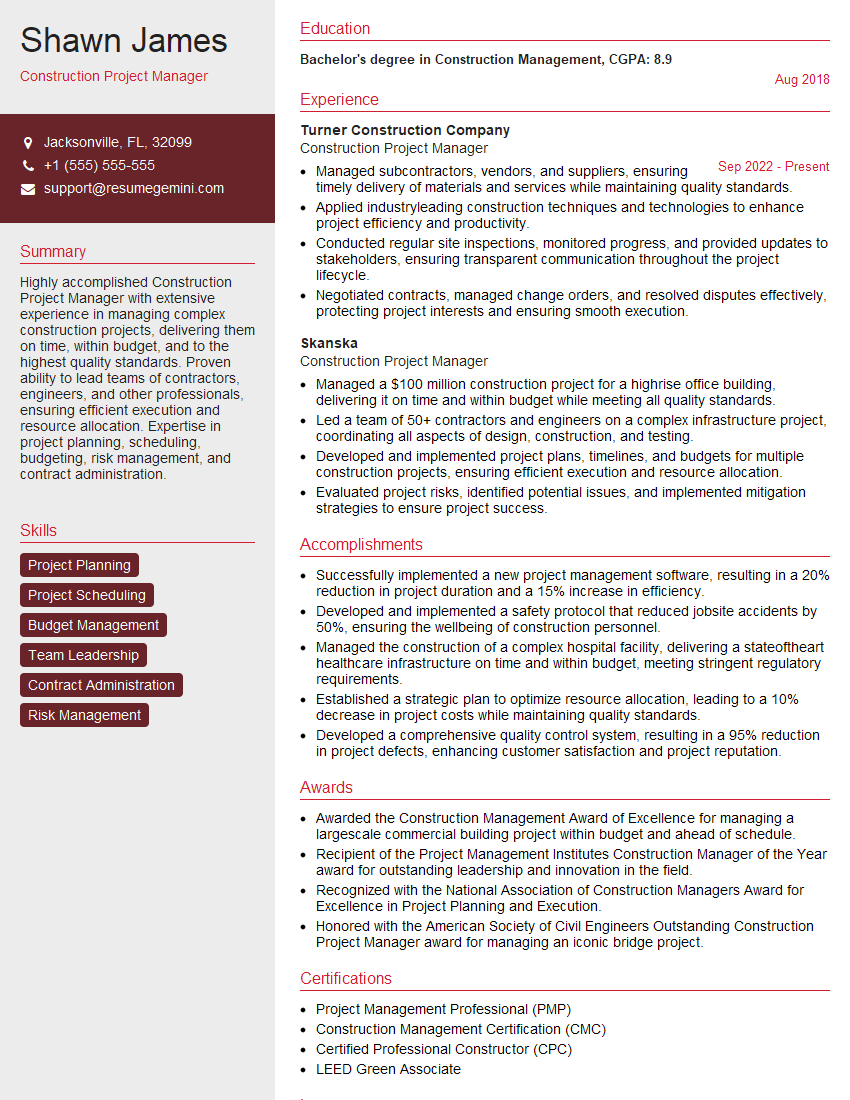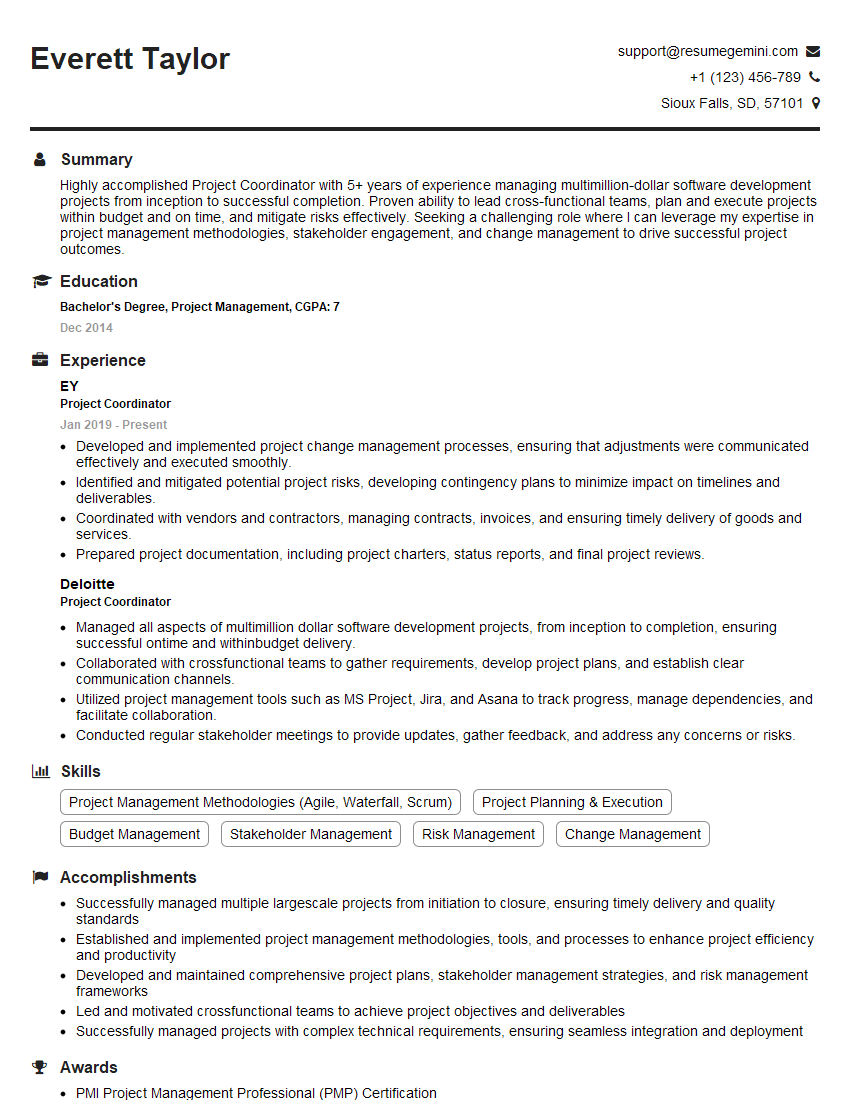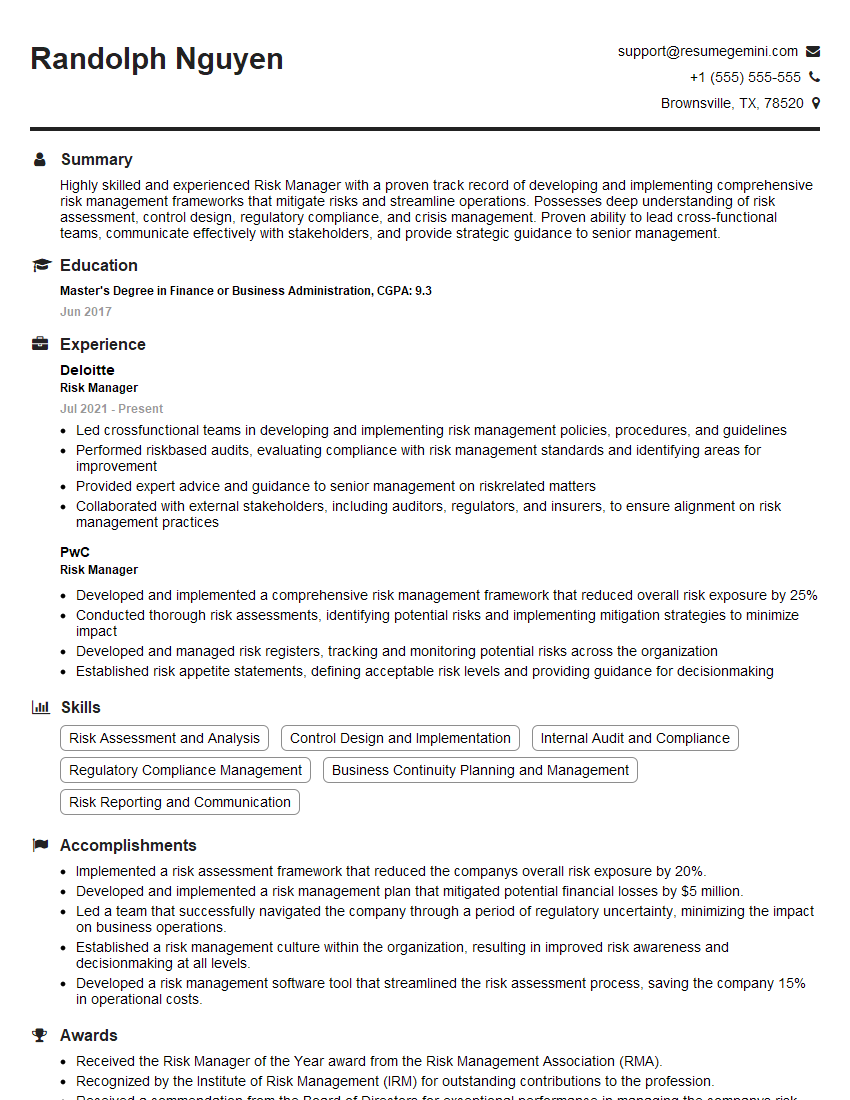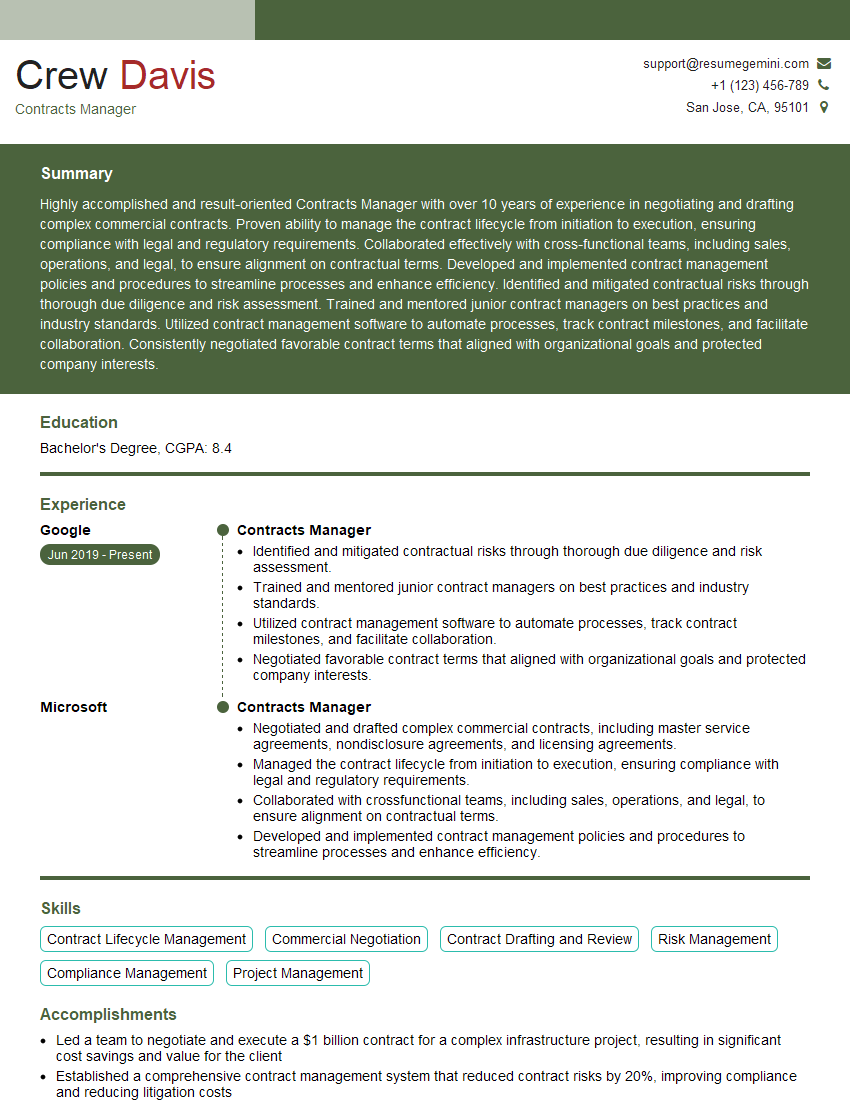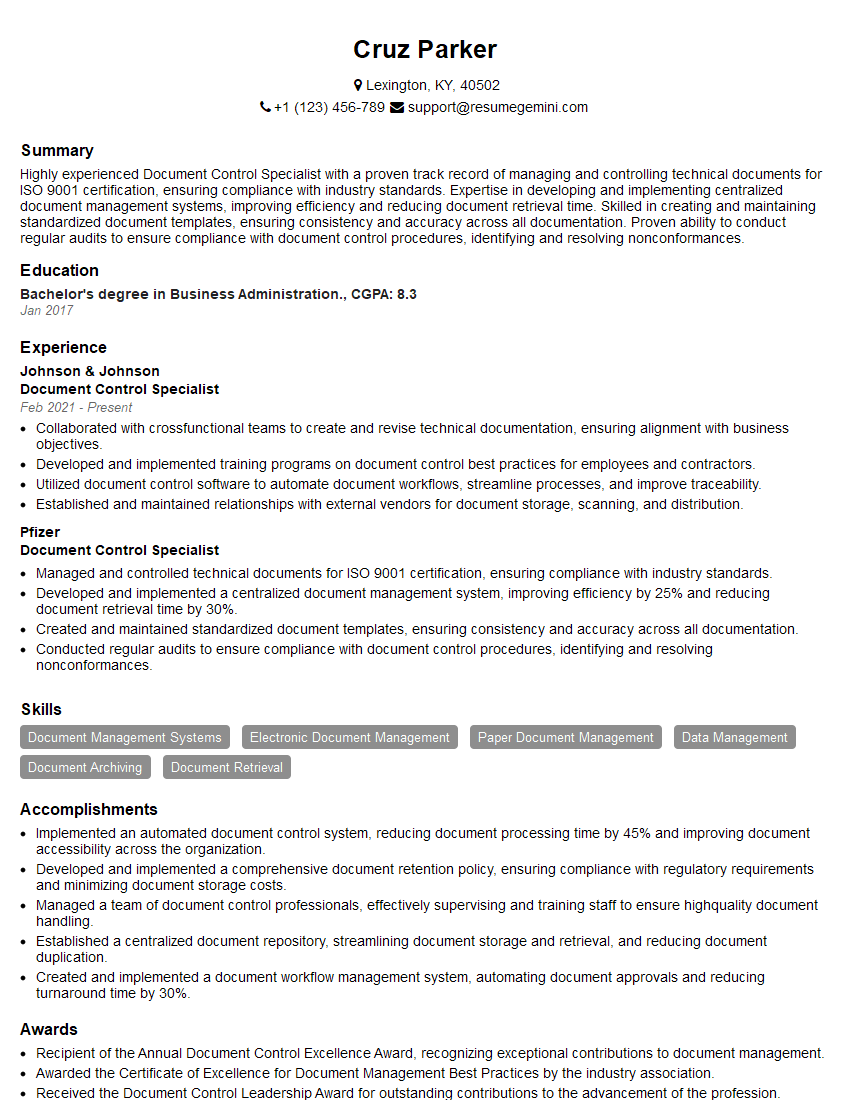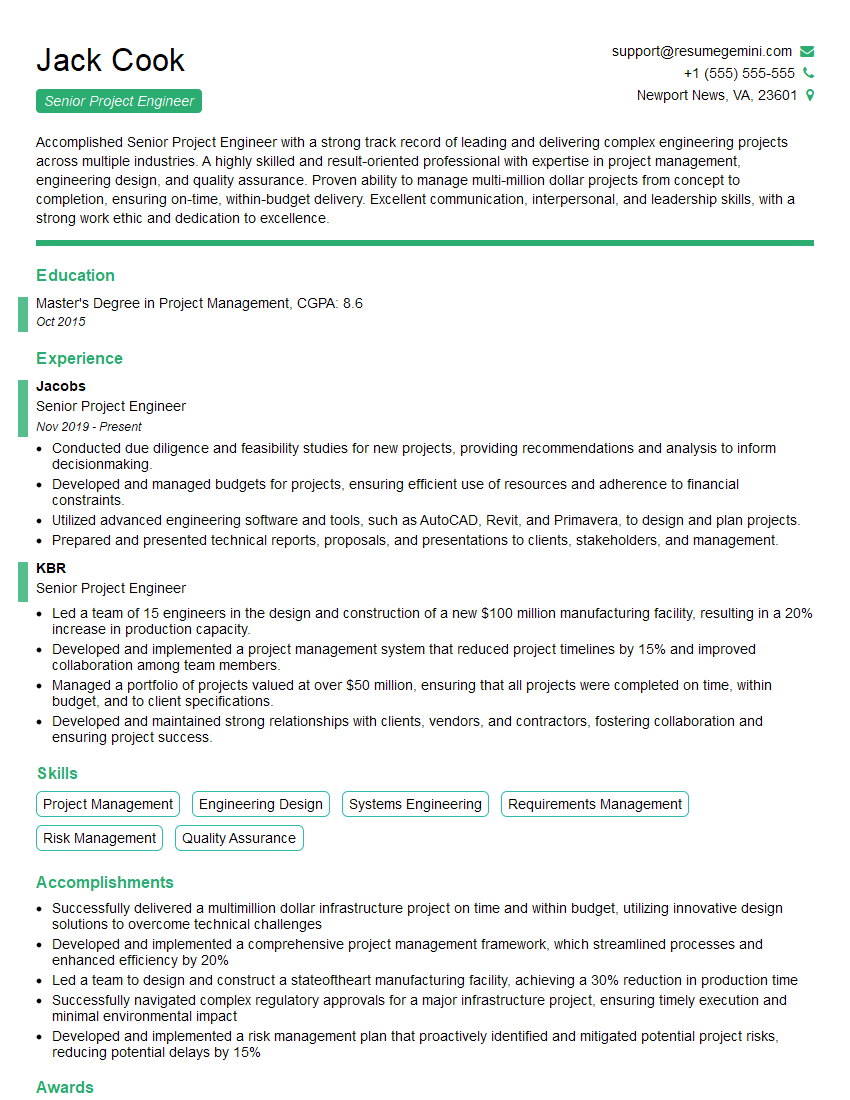The thought of an interview can be nerve-wracking, but the right preparation can make all the difference. Explore this comprehensive guide to Change Order Processing interview questions and gain the confidence you need to showcase your abilities and secure the role.
Questions Asked in Change Order Processing Interview
Q 1. Explain the process of initiating a change order.
Initiating a change order begins with identifying a need for alteration from the original project scope. This could stem from various reasons, like design modifications, unforeseen site conditions, or client requests. The process usually involves submitting a formal request, detailing the proposed changes, their rationale, and the expected impact on the project timeline and budget.
Step-by-step process:
- Identify the need: Pinpoint the discrepancy between the original plan and the current requirement.
- Document the request: Create a comprehensive document outlining the proposed changes, including drawings, specifications, and justifications.
- Submit the request: Forward the documented request through the established channels, typically to the project manager and relevant stakeholders.
- Review and approval: The request undergoes review, often involving multiple parties such as the client, project manager, and possibly engineering or legal teams. This stage includes cost estimation and impact assessment.
- Formal issuance: Once approved, the change is formally documented as a change order, assigning a unique identifier and outlining the agreed-upon terms, including cost, schedule adjustments, and responsibilities.
For example, imagine constructing a building where the client requests an upgrade to the flooring material mid-project. This initiates the change order process. The request needs to be formally documented, reviewed, approved and then a change order number issued.
Q 2. Describe the different types of change orders.
Change orders can be categorized in several ways, but common types include:
- Design Changes: Modifications to the original design specifications, such as altering building materials or structural elements.
- Scope Changes: Additions or deletions of work, impacting the overall project scope. For example, adding a new feature or removing an unnecessary component.
- Time Changes: Extensions or reductions in the project’s timeline, often linked to other change orders.
- Cost Changes: Adjustments to the original budget, resulting from design, scope, or time changes. These can involve both increases and decreases.
- Corrective Changes: Addressing errors or deficiencies discovered during the project execution.
Think of it like building a house. A design change might be switching from hardwood to laminate flooring. A scope change might be adding a sunroom. A time change could be a delay due to inclement weather affecting the construction schedule.
Q 3. How do you ensure accurate cost estimation for change orders?
Accurate cost estimation is critical for successful change order management. It requires a detailed understanding of the project, the proposed changes, and potential impacts. We use a combination of methods to ensure accuracy:
- Detailed Quantity Takeoff: Precisely measuring the quantities of materials and labor needed for the change.
- Unit Costing: Establishing accurate unit costs for materials, labor, and equipment based on current market rates and historical data.
- Contingency Planning: Including a buffer to account for unforeseen issues or cost fluctuations.
- Risk Assessment: Identifying and quantifying potential risks that could impact the cost.
- Peer Review: Having another estimator review the calculations to ensure accuracy and catch potential errors.
For example, if a change order involves adding a new section to a building, we wouldn’t just estimate the cost of materials; we’d break it down to concrete, steel, labor, permits, etc., and factor in potential delays and associated costs.
Q 4. What is the importance of proper documentation in change order processing?
Proper documentation is the backbone of effective change order processing. It provides a clear audit trail, mitigates disputes, and ensures everyone is on the same page. This involves meticulously documenting every aspect of the change, from initial request to final approval and implementation.
- Change Order Form: A standardized form capturing all relevant information, including a unique identifier, date, description of changes, justification, cost breakdown, and signatures of all approving parties.
- Supporting Documentation: Including drawings, specifications, and any other relevant information to support the change request.
- Communication Logs: Maintaining a record of all communications related to the change order.
- Progress Reports: Tracking the implementation progress and reporting any deviations from the plan.
- Change Order Register: A central repository for all change orders, providing a comprehensive overview of project changes.
Imagine a situation where a dispute arises over the cost of a change order. Robust documentation would provide irrefutable evidence of the agreed-upon price, protecting all parties involved.
Q 5. How do you handle disputes arising from change orders?
Disputes related to change orders are best handled proactively through clear communication and comprehensive documentation. When disputes do arise, a structured approach is essential:
- Review the contract: Understand the contract’s terms and conditions regarding change orders, dispute resolution mechanisms and escalation pathways.
- Open communication: Foster open communication between all parties involved to understand the points of contention.
- Mediation: Consider mediation as a neutral, cost-effective approach to resolve the dispute.
- Arbitration or litigation: If mediation fails, arbitration or litigation may be necessary as a last resort.
A common dispute could revolve around cost overruns. Thorough documentation, including detailed cost estimates and justifications, can significantly strengthen your position during dispute resolution.
Q 6. Explain your experience with change order tracking and reporting.
My experience in change order tracking and reporting involves utilizing various methods to monitor, analyze, and report on changes throughout a project’s lifecycle. I’ve implemented systems to track each change order’s status, from initiation to completion, leveraging both manual and automated tracking methods.
I am proficient in developing comprehensive reports that provide insights into the overall impact of change orders on project schedules, budgets, and resources. These reports are crucial for project management, stakeholder communication and decision-making. I have extensive experience generating reports that show the cumulative impact of all changes on the project’s overall budget and timeline, offering valuable data for future project planning.
In past roles, I’ve designed and implemented custom dashboards providing real-time visibility into change order status, helping teams proactively manage potential risks and bottlenecks.
Q 7. Describe your experience with different change order software.
I have experience with various change order management software, including both cloud-based and on-premise solutions. This includes experience with software like PlanGrid, Procore, and e-Builder. My experience extends to selecting, implementing, configuring, and training users on these systems.
The choice of software depends on project size, complexity, team size and budget. Cloud-based solutions often provide greater scalability and accessibility, while on-premise solutions might offer greater control over data security. My experience allows me to assess project requirements and choose the best fit software solution.
Q 8. How do you prioritize change orders in a busy project?
Prioritizing change orders in a busy project requires a systematic approach. It’s not simply about the order they arrive; it’s about their impact on the project’s overall success. I use a multi-criteria prioritization system, often incorporating a weighted scoring matrix. This involves identifying key criteria such as:
- Urgency: How quickly does this change need to be implemented to avoid significant delays or cost overruns?
- Impact: How significant is the effect of this change on the project scope, schedule, and budget?
- Risk: What are the potential consequences of delaying or improperly implementing this change?
- Dependencies: Does the implementation of this change depend on other changes or tasks being completed first?
Each criterion is assigned a weight based on its importance to the project’s objectives. Each change order is then scored against these criteria. The change orders with the highest overall scores are prioritized first. For example, a change order impacting critical path activities with a high risk of delay would score higher than a minor aesthetic change. Regularly reviewing and updating this matrix is crucial to ensure it remains aligned with the project’s evolving needs. Using project management software with custom fields and reporting capabilities greatly streamlines this process.
Q 9. How do you ensure timely processing of change orders?
Timely change order processing is crucial for maintaining project momentum and avoiding disputes. To ensure this, I employ a streamlined process involving clearly defined roles, responsibilities, and deadlines. This involves:
- Dedicated Change Order Team: Establishing a team responsible for managing the entire change order lifecycle.
- Centralized System: Utilizing a centralized system (e.g., project management software) to track all change orders, their status, and associated documentation.
- Clear Approval Workflow: Implementing a documented workflow with clearly defined approval authorities and timelines at each stage (request, review, approval, implementation, closure).
- Regular Monitoring and Reporting: Regularly monitoring the progress of change orders and reporting on any delays or issues to project stakeholders.
- Automated Notifications: Setting up automated email notifications to keep all relevant parties informed about changes in the change order status.
In addition to these measures, proactive communication with all stakeholders is vital. Setting expectations early on about processing times and maintaining transparency throughout the process reduces frustration and helps manage expectations effectively. Regular status meetings dedicated to discussing change orders further facilitate timely resolution.
Q 10. How do you manage change orders that impact project schedules?
Change orders that impact project schedules require careful management. My approach involves a combination of proactive planning, impact assessment, and schedule adjustments. This includes:
- Immediate Impact Assessment: As soon as a change order is received, a thorough impact assessment is conducted to determine its effects on the critical path and project schedule.
- Schedule Update: The project schedule is updated to reflect the changes. This often involves using scheduling software to analyze the effect of the change order on task durations, dependencies, and milestones.
- Negotiation and Mitigation: Negotiation with stakeholders might be necessary to determine the best way to mitigate the impact on the schedule (e.g., adjusting priorities, accelerating tasks, or extending the project timeline). This requires open communication and collaboration.
- Documentation: All schedule changes resulting from the change order are meticulously documented and communicated to all stakeholders.
- Contingency Planning: Developing contingency plans to account for potential unforeseen delays or challenges during the implementation of the change.
For instance, if a change order requires additional work that impacts the critical path, I’d use project management software to assess the delay. I’d then work with the team and stakeholders to determine whether to compress the schedule, adjust priorities, or extend the project timeline. The key is transparency and proactive communication.
Q 11. What is your approach to negotiating change orders?
Negotiating change orders requires a collaborative and professional approach. My strategy is built on clear communication, a strong understanding of the contract, and a focus on mutually beneficial outcomes. This involves:
- Defining the Scope: Clearly defining the scope of the change order, including all deliverables and expectations.
- Cost Estimation: Developing a detailed cost estimate that accounts for all direct and indirect costs associated with the change.
- Timeline Assessment: Determining the impact of the change on the project schedule and associated timelines.
- Documentation: Meticulously documenting all aspects of the negotiation process, including agreements and any compromises made.
- Win-Win Approach: Focusing on a win-win solution that balances the needs of all parties involved. Sometimes this means finding creative solutions, such as trading one change for another, or adjusting scope to keep the overall budget and schedule intact.
For example, if a client requests a significant design change, I would first thoroughly assess the impact on cost and schedule. Then, I would present them with various options and their associated costs and time implications, ultimately aiming for a solution that addresses their needs while maintaining project viability.
Q 12. How do you handle change orders outside the formal process?
Change orders outside the formal process are highly problematic and should be avoided. They create confusion, undermine control, and can lead to disputes and cost overruns. However, if such a situation arises, I immediately take steps to bring it within the formal process. This includes:
- Formal Documentation: Documenting the change request, including the details of the request, the reason for bypassing the formal process, and any relevant communication.
- Review and Approval: Getting the change formally reviewed and approved through the established channels.
- Cost and Schedule Impact Assessment: Conducting a thorough assessment of the impact on cost and schedule, even if the change was implemented informally.
- Communication: Communicating the details of the change order to all relevant stakeholders, including the reason for the initial deviation from the formal process.
- Prevention: Analyzing the reason why the formal process was bypassed and implementing measures to prevent such occurrences in the future.
The key is to quickly rectify the situation and prevent the recurrence of informal changes. This might involve reinforcing training on the formal change order process, or simplifying the process to make it more user-friendly. The goal is to ensure that all changes are managed in a controlled and transparent manner.
Q 13. Explain your understanding of contract law as it relates to change orders.
Contract law is fundamental to change order processing. The contract defines the scope of work, payment terms, and the procedures for making changes. A change order is essentially a modification to the original contract. It’s crucial to understand:
- Scope of Work: The contract’s initial scope of work serves as the baseline against which changes are measured. Changes outside this scope are typically subject to change orders.
- Change Order Clause: The contract should contain a clause outlining the process for requesting, reviewing, and approving change orders. This clause should detail requirements for documentation, cost estimation, and approval authorities.
- Payment Terms: The contract should specify how changes will be reflected in payments, including pricing mechanisms (e.g., time and materials, fixed price) and payment schedules.
- Dispute Resolution: The contract should outline the process for resolving disputes arising from change orders, potentially including mediation or arbitration.
Ignoring the contract’s terms can lead to costly disputes. Careful adherence to the contractual change order process protects both the client and the contractor. A change order should always be considered a formal amendment to the contract, requiring mutual agreement and proper documentation. Understanding contract law is essential for mitigating legal risks associated with change orders.
Q 14. How do you identify potential change orders proactively?
Proactive identification of potential change orders is essential for effective project management. It allows for early planning, mitigation of risks, and a smoother project execution. My approach involves:
- Thorough Planning: A comprehensive project plan with detailed specifications and clear deliverables reduces the likelihood of unforeseen changes.
- Regular Reviews: Conducting regular project reviews with the project team and stakeholders to identify potential issues or areas requiring clarification.
- Risk Management: Employing a formal risk management process to identify and assess potential risks that could lead to change orders.
- Communication: Maintaining open and consistent communication with all stakeholders to identify and address potential issues early.
- Design Reviews: Conducting design reviews to identify potential flaws or ambiguities in the design that could lead to changes later in the project.
For instance, during design reviews, I may identify a conflict between two different design elements. Proactively addressing this conflict through a formal change order prevents costly rework later. Similarly, conducting regular site visits allows early identification of unforeseen site conditions that might require changes to the project plan. The key is to foster a culture of proactivity, where potential problems are identified and addressed before they escalate.
Q 15. What metrics do you use to measure the effectiveness of change order processing?
Measuring the effectiveness of change order processing requires a multi-faceted approach, focusing on both efficiency and impact on project outcomes. Key metrics include:
- Change Order Cycle Time: This measures the time taken from change request submission to final approval and implementation. A shorter cycle time indicates a more efficient process. We aim for a cycle time under X days, depending on the complexity of the order.
- Change Order Approval Rate: This tracks the percentage of submitted change orders that are ultimately approved. A high approval rate might indicate a robust change management process that considers only valid requests or a lack of upfront planning. A low rate suggests rigorous review, but may also point to inefficient change processes or excessive project rigidity.
- Cost Variance Due to Change Orders: This metric compares the total cost of change orders to the original project budget. A high variance necessitates improvements in estimating and change control. We aim to keep this below Y% of the total budget.
- Number of Change Orders: While a few change orders are normal, an excessively high number might indicate inadequate planning or design flaws. This needs investigation to reduce future occurrences.
- Customer Satisfaction with Change Order Handling: Feedback from clients on the responsiveness and transparency of the change order process is crucial. Regular surveys and feedback sessions help improve client experience.
By tracking these metrics, we can identify bottlenecks, areas for improvement, and measure the overall effectiveness of our change order management system. We regularly review these metrics and adapt our processes to improve our performance.
Career Expert Tips:
- Ace those interviews! Prepare effectively by reviewing the Top 50 Most Common Interview Questions on ResumeGemini.
- Navigate your job search with confidence! Explore a wide range of Career Tips on ResumeGemini. Learn about common challenges and recommendations to overcome them.
- Craft the perfect resume! Master the Art of Resume Writing with ResumeGemini’s guide. Showcase your unique qualifications and achievements effectively.
- Don’t miss out on holiday savings! Build your dream resume with ResumeGemini’s ATS optimized templates.
Q 16. How do you prevent change orders from becoming a project bottleneck?
Preventing change orders from becoming a project bottleneck requires a proactive and structured approach. Think of it like managing traffic flow – you need clear signals, efficient routes, and quick responses to unexpected events. Key strategies include:
- Robust Change Management Process: A well-defined process with clear roles, responsibilities, and timelines ensures consistency and prevents delays. This includes clearly defined escalation paths and decision-making authorities.
- Proactive Risk Management: Identifying and mitigating potential changes during the planning phase minimizes unexpected disruptions. This involves thorough risk assessments and contingency planning.
- Thorough Planning and Design: Comprehensive upfront planning and detailed design reduce the need for changes later in the project lifecycle. Regular review meetings and design walkthroughs are valuable tools.
- Effective Communication: Open communication between stakeholders ensures that everyone is informed about potential changes and their implications. This fosters collaborative problem-solving.
- Streamlined Approval Process: A fast and efficient approval process minimizes delays. We use automated workflows and tools wherever possible to accelerate approvals.
- Regular Monitoring and Reporting: Closely monitoring the change order process allows for early identification of potential bottlenecks. Regular reporting keeps stakeholders informed and allows for proactive adjustments.
By implementing these strategies, we aim to keep change orders from creating a cascade of delays and cost overruns.
Q 17. How do you handle change orders with significant cost implications?
Handling change orders with significant cost implications requires a more structured and rigorous approach. It’s like navigating a complex financial landscape – you need a clear map, careful consideration, and expert guidance. The process involves:
- Detailed Cost Analysis: A comprehensive cost analysis is critical to understand the true financial impact of the proposed change. This includes not only direct costs but also indirect costs, potential delays, and long-term implications.
- Impact Assessment: Assessing the impact of the change on the project schedule, budget, and scope is essential. This involves stakeholder consultations to understand the ramifications of the change.
- Value Engineering: Exploring alternative solutions to achieve the desired outcome at a lower cost is vital. Creative problem-solving and value engineering workshops can help in finding more cost-effective solutions.
- Formal Change Request: A detailed and formal change request documenting the proposed change, cost implications, and rationale is essential. This allows for a transparent review process.
- Senior Management Approval: Changes with significant cost implications typically require approval from senior management or a dedicated change control board. Their oversight adds an extra layer of scrutiny and accountability.
- Contractual Considerations: Reviewing the project contract and its clauses regarding change orders is crucial to understand the legal and contractual implications. We consult legal counsel where necessary.
This detailed approach helps to control costs and avoid financial surprises.
Q 18. Explain your experience with change order approvals and authorizations.
My experience with change order approvals and authorizations involves implementing and managing a robust, multi-level approval system. This system ensures transparency, accountability, and adherence to organizational policies. The process typically includes:
- Formal Request Submission: All change requests are submitted through a standardized form, detailing the proposed change, justification, and cost implications.
- Initial Review and Assessment: The project manager reviews the request for completeness and initial feasibility. A technical review may be required.
- Multiple Levels of Approval: Depending on the scope and cost of the change, the request may require approval from various stakeholders, including the project sponsor, department heads, and potentially senior management. A clear authorization matrix defines roles and responsibilities.
- Documentation and Tracking: Every stage of the approval process is meticulously documented and tracked using a dedicated change management system. This ensures complete auditability and accountability.
- Notification and Communication: All stakeholders are informed of the status of the change order at every stage. This transparency maintains alignment and collaboration.
We employ a system of electronic approvals and notifications to streamline this process and enhance efficiency. This has significantly reduced the time and effort associated with change order approvals.
Q 19. Describe a situation where a change order caused a significant project delay. How did you handle it?
In one project, a late-stage change order, requiring a significant redesign of a key system component, caused a three-month delay. The initial assessment underestimated the complexity and interdependencies. The resulting ripple effect impacted subsequent phases. To handle this:
- Immediate Impact Assessment: We convened an emergency meeting to assess the full impact of the delay on the project timeline, budget, and deliverables.
- Revised Schedule and Budget: We created a revised project schedule and budget, incorporating the delay and additional costs. This required close collaboration with the client and other stakeholders.
- Mitigation Strategies: We implemented mitigation strategies to minimize further delays, including streamlining processes, allocating additional resources, and working overtime where necessary.
- Transparent Communication: We maintained open and honest communication with the client, keeping them informed of our progress and the challenges we faced. This preserved trust and prevented further conflicts.
- Lessons Learned Review: We conducted a thorough post-project review to analyze the root causes of the delay and identify areas for improvement in our change management processes. This resulted in improved risk management practices and more rigorous change impact assessments.
This experience highlighted the importance of thorough upfront planning, robust risk management, and clear communication in managing change orders, particularly those with potential for significant impact.
Q 20. How do you ensure that all stakeholders are informed about change orders?
Ensuring all stakeholders are informed about change orders is crucial for project success. We utilize a multi-pronged approach that combines various communication channels to reach all parties effectively.
- Centralized Change Management System: We use a dedicated system for documenting and tracking change orders, providing a single source of truth for all stakeholders to access the latest information.
- Automated Notifications: The system automatically notifies relevant stakeholders via email or other preferred channels whenever a change order is submitted, updated, or approved. This minimizes delays and ensures timely information dissemination.
- Regular Project Meetings: Change orders are discussed in regular project meetings, allowing for open communication and collaborative problem-solving. Minutes from these meetings are documented and shared.
- Dedicated Communication Channels: We use project management software, email, and other communication platforms to ensure that stakeholders receive information in a timely and easily accessible format.
- Formal Change Order Documentation: Each change order is documented clearly, including all relevant details and approvals. This ensures a complete audit trail and simplifies communication.
This multifaceted approach ensures transparency and minimizes misunderstandings, fostering collaboration and confidence among all stakeholders.
Q 21. What software or tools have you used for change order management?
Throughout my career, I’ve utilized several software and tools for change order management, adapting to the specific needs of each project. Some examples include:
- Project Management Software (e.g., MS Project, Primavera P6): These platforms offer features for change order tracking, scheduling updates, and cost management.
- Document Management Systems (e.g., SharePoint, Dropbox): These systems provide central repositories for storing and accessing change order documentation, ensuring version control and easy collaboration.
- Custom-built Change Order Management Systems: In some organizations, we have worked with custom-developed systems tailored to specific workflow needs and reporting requirements.
- Collaboration Platforms (e.g., Slack, Microsoft Teams): These platforms facilitate real-time communication and collaboration among stakeholders, keeping everyone informed on progress.
The choice of software depends largely on the project size, complexity, and organizational preferences. The key is to select a system that supports a streamlined and efficient change order process.
Q 22. How do you integrate change orders into the project budget?
Integrating change orders into the project budget requires a meticulous approach. It’s not simply adding the cost; it’s about understanding the impact on the overall project timeline and resource allocation. First, a detailed cost estimate for the change is prepared, outlining all associated labor, materials, and equipment. This estimate should be reviewed and approved by relevant stakeholders. Then, the approved change order cost is incorporated into the updated project budget. This often involves revising the budget baseline, potentially reallocating funds from other areas or requesting additional funding.
For example, imagine a construction project where a change order is requested to upgrade the flooring. We’d estimate the cost of the new flooring, installation labor, potential disposal fees of the existing flooring, and any project delays. This total cost is then added to the original budget, with an explanation of where the funds will come from – perhaps by reducing the budget for a less critical area or by seeking additional funding from the client.
It’s crucial to maintain a transparent and documented process, using budget management software to track the changes and ensure all stakeholders are informed of the revised budget. This helps in preventing cost overruns and maintaining project financial health.
Q 23. How do you handle change orders related to unforeseen circumstances?
Handling change orders stemming from unforeseen circumstances requires a swift and methodical response. The first step is to thoroughly document the situation, including photos, reports from affected parties, and any relevant communication logs. Next, a thorough assessment is conducted to determine the impact of the unforeseen event on the project scope, schedule, and budget. A change order proposal is then prepared, outlining the necessary corrective actions, the associated costs, and the revised timeline. This proposal is submitted to the client for approval. It’s important to highlight the emergent nature of the situation and emphasize the criticality of timely approval to minimize further delays or escalation of costs.
For instance, if a sudden storm damages a partially constructed building, the change order would cover repairs, potential delays in the project, and additional labor costs required for cleanup and remediation. We would detail all costs and provide a revised project completion date. This documentation is crucial for insurance claims, disputes, and for future risk assessment.
Q 24. What is your experience with preparing change order justifications and proposals?
Preparing change order justifications and proposals is a key part of my expertise. My approach focuses on clarity, comprehensiveness, and persuasive communication. Each justification starts with a clear statement of the proposed change, followed by a detailed explanation of the reasons necessitating the change. I include relevant supporting documentation such as design drawings, specifications, cost estimates, and impact analyses. The proposal includes options for addressing the change, their associated costs and timelines, and a recommendation based on the most cost-effective and efficient approach.
For example, if a client wants to modify a building’s facade, the justification would explain the client’s request, its impact on the original design, structural implications (if any), the associated costs for materials and labor, and the impact on the project timeline. We’d include supporting images and technical specifications. The proposal might offer several options: a simplified modification, a more elaborate one, or even the possibility of sticking to the original design.
It’s crucial to present these justifications and proposals in a professional and understandable manner to ensure easy approval from stakeholders and avoid disputes down the line.
Q 25. How do you ensure compliance with relevant regulations and standards regarding change orders?
Ensuring compliance with regulations and standards is paramount in change order processing. This involves staying updated on all relevant legislation, industry codes, and contractual requirements applicable to the project. Every change order must be reviewed to ensure it meets all relevant safety standards, building codes, environmental regulations, and contractual obligations. We maintain a thorough audit trail for each change order, including approvals, revisions, and final acceptance. This ensures transparency and accountability. Non-compliance can lead to significant penalties, project delays, and legal issues.
For instance, in a construction project, we’d need to check if the proposed change complies with local building codes regarding structural integrity, fire safety, and accessibility. Any deviation would require obtaining necessary permits and approvals before initiating the change. We would also meticulously document all these compliance checks for future reference.
Q 26. Describe your experience working with different contract types and their impact on change order processing.
My experience spans various contract types, including lump-sum, cost-plus, and time-and-materials contracts. Each type significantly impacts change order processing. In a lump-sum contract, changes are more strictly controlled, requiring detailed justifications and formal approvals. The change order process is often more complex, with a rigorous change-impact analysis to determine cost implications. Cost-plus contracts offer more flexibility, but require meticulous tracking of costs and accurate accounting of change-related expenses. Time-and-materials contracts are more straightforward for smaller changes but require tight control to prevent cost overruns. Understanding the nuances of each contract type is critical to effective change order management.
For example, a change order in a lump-sum contract might require a more extensive review and approval process, while a similar change in a cost-plus contract could be relatively simpler to implement, provided cost is appropriately documented. This understanding ensures we tailor the change order process to the specific contractual framework, minimizing potential disputes.
Q 27. How do you utilize change order data to improve future project planning?
Change order data is a valuable resource for improving future project planning. By analyzing the frequency, types, and causes of change orders across past projects, we can identify patterns and potential risks. This analysis helps in refining project scope definition, improving initial cost estimates, and enhancing risk management strategies. For example, if a particular type of change order frequently occurs in similar projects, it suggests the need for more detailed planning or potentially even design modifications to prevent that type of issue in future undertakings. This data-driven approach helps mitigate future cost overruns, delays, and unexpected issues.
We use data analysis tools and techniques to analyze change order data, identifying trends, common causes, and potential improvements in project planning processes. This helps to develop more robust project plans and improves overall project success.
Q 28. How do you communicate effectively about complex change order issues to non-technical stakeholders?
Communicating complex change order issues to non-technical stakeholders requires clear, concise, and accessible language. I avoid technical jargon and use relatable analogies to explain the impact of changes on project objectives. I present information visually using charts, graphs, and summaries to highlight key points. I also proactively seek feedback to ensure everyone understands the implications and implications of the change order. I prepare presentations, summaries and frequently asked questions documents to address common concerns proactively.
For instance, rather than saying “the revised schedule impacts the critical path,” I might say “the delay due to the change will push back the project completion by two weeks,” This simplification makes the information readily understandable and helps prevent misinterpretations. This proactive, transparent communication fosters better collaboration and ensures stakeholders are informed and involved throughout the process.
Key Topics to Learn for Change Order Processing Interview
- Understanding Change Orders: Defining change orders, their purpose, and the different types (e.g., scope changes, time extensions, cost adjustments).
- Change Order Documentation: Mastering the process of creating, reviewing, and approving change order requests, including proper formatting and required approvals.
- Contractual Aspects: Analyzing contracts to identify clauses related to change orders, understanding the implications of change order approvals, and potential disputes.
- Cost Estimating & Budgeting: Accurately estimating the cost impact of proposed changes and incorporating these into project budgets.
- Impact Analysis: Assessing the effect of change orders on project timelines, resources, and overall project success.
- Workflow & Processes: Understanding the complete workflow from initiation of a change request to final approval and implementation, including relevant software and systems.
- Risk Management: Identifying and mitigating potential risks associated with change orders, including cost overruns, schedule delays, and contract disputes.
- Communication & Collaboration: Effectively communicating change order information to stakeholders, including clients, project managers, and team members.
- Problem-Solving & Decision-Making: Applying critical thinking skills to address complex change order issues and make informed decisions.
- Software & Tools: Familiarity with relevant software used for change order management (mentioning specific software is optional, focus on the general principles instead).
Next Steps
Mastering Change Order Processing is crucial for career advancement in project management and related fields. It demonstrates your ability to manage complex situations, mitigate risks, and ensure project success. To significantly boost your job prospects, create an ATS-friendly resume that highlights your skills and experience effectively. We strongly recommend using ResumeGemini, a trusted resource, to build a professional and impactful resume. ResumeGemini provides examples of resumes tailored to Change Order Processing to help you create a compelling application that gets noticed.
Explore more articles
Users Rating of Our Blogs
Share Your Experience
We value your feedback! Please rate our content and share your thoughts (optional).
What Readers Say About Our Blog
Hi, I have something for you and recorded a quick Loom video to show the kind of value I can bring to you.
Even if we don’t work together, I’m confident you’ll take away something valuable and learn a few new ideas.
Here’s the link: https://bit.ly/loom-video-daniel
Would love your thoughts after watching!
– Daniel
This was kind of a unique content I found around the specialized skills. Very helpful questions and good detailed answers.
Very Helpful blog, thank you Interviewgemini team.
